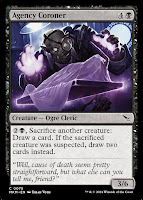OTJ introduces the following key words, ability words, or card subtypes:
- Plot [x]: Relevant to 38 cards, this mechanic lets you pay a cost and keep the card in exile, to be played on a later turn for free. Some cards give benefits for plotting. Rules text: (You may pay [x] and exile this card from your hand. Cast it as a sorcery on a later turn without paying its mana cost. Plot only as a sorcery.)
- Crime: Mentioned on 26 cards, 'commiting a crime' pays. (Targeting opponents, anything they control, and/or cards in their graveyards is a crime.)
- Spree: On 21 cards, this is a variant of kicker, giving multiple effects depending on how much you pay. (Choose one or more additional costs.)
- Saddle: On 17 cards, you can saddle a mount, which is a new creature subtype. Attacking with a saddled mount general gives some effect. Saddle [x] (Tap any number of other creatures you control with total power [x] or more: This Mount becomes saddled until end of turn. Saddle only as a sorcery.)
- Outlaws: Mentioned on 15 cards, playing outlaws has its benefits. They are one or more of five creature subtypes. (Assassins, Mercenaries, Pirates, Rogues, and Warlocks are outlaws.)
Themes/Flavor
OTJ is set on a new plane. This is "Magic does the wild west." Combine Magic characters/fantasy archetypes with wild west motifs and you get the idea. Puns abound; personal favorites include 'bovine intervention' and 'holy cow':
They even play on Looney Tunes with a coyote and roadrunner:
The themes in the set are captured well by the mechanics: plotting, crimes, outlaws, sprees, and saddled creatures. Deserts (a subtype of land cards) or those that benefit from them are also featured:
Thoughts
Despite having only a few days to explore it, this set looks to be a winner. It is immersive and playful. The one thing I find odd is the juxtaposition of fantasy characters (especially popular Magic ones with developed backstories) and the wild west theme. It almost seems like Magic characters are doing cosplay. (I feel like Wizards could have released a spin-off, stand-alone version of this expansion based on historical characters/etc. That would have been really cool.) That aside, I look forward to exploring this further.






























































